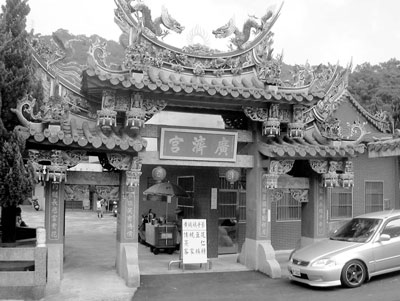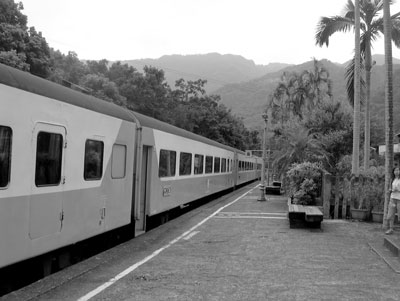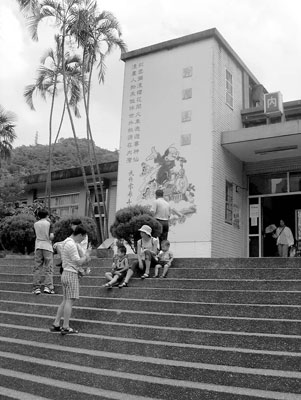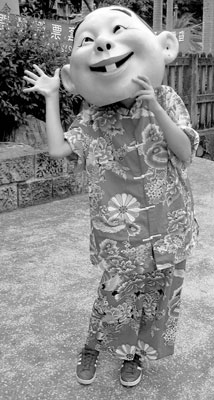Taiwan’s Neiwan Railroad
by Jay Brunhouse
Costumed greeters wearing comic heads dance before the crowds passing out of Neiwan’s modern train station in the high hills of Taiwan. Children squeal happily at the sight. The street is lined with endless stalls offering delicious treats, which together form a special kind of market. One sight nearby is the Taoist Jai Kung Temple of Mercy.
Neiwan, a part of Hengshan Town in Hsinchu County, is a mountain village. It used to be home to several coal mines and was once a prosperous little village teeming with bars, restaurants and movie theaters, yet when the last of the coal mines closed, the village lost a major portion of its income, but it has since developed its own tourist industry.
Upon arrival at the village, you will be immediately dazzled by breathtaking mountain views. A 482-foot suspension bridge over Youluo Creek linking Neiwan to the village of Nanping is a major attraction. The span is supported by two specially designed piers and draws a multitude of visitors.
All Aboard!
Your journey along the Neiwan Railroad through hilly Hsinchu County begins when your train from Taipei veers off of Taiwan’s West Coast Mainline at the high-tech city of Hsinchu. During the long stop there, new crowds storm aboard and fill almost all of the seats. As the train starts uphill in the opposite direction of travel, which astonishes some passengers, they turn the seats to face in the new direction.
The conductor passes through the train with a digital ticket printer. No one buys a ticket. It is almost like an honor system.
On the outskirts of Hsinchu, you pass Technology Park. There is lots of money here. The MIT Company (not the university) has a research building rising to your right, south of your train. As you climb, gradually the flora increases in beauty. Yellow blossoms surround your train and red-blooming trees line the hillsides.
Your first stop on the Neiwan Line is the new station of Ronghua, built on space that was formerly devoted to rice paddies. An early 2004 superhighway passes over the earlier railroad line, showing the modernization that Taiwan is undergoing.
Past Jhudong Station, which has two platforms to allow trains to pass and stairs leading to the overpass connecting them, you pass a former cement factory used by the Japanese. A chilly river rushes down from the Lineshu Mountains.
Jiouzantou is the site of another cement factory, but you can see more backyards devoted to rice culture. Palm trees flourish and papayas ripen on their trees, but as you continue to rise you see cypress trees for the first time.
At Hesing, your train makes a switchback and enters a long tunnel. Exiting the tunnel, you have a vista of majestic green-clad hills. A quarry in the valley below is excavating gravel as fast as its conveyer belt will permit.
Green bamboo stalks towering 30 feet block your view as you climb higher. Through another tunnel, you breath cooler, refreshing air and the river below is smaller but gaining strength. You have arrived at your destination, Neiwan, the popular market town and tourist destination.
Railroad renaissance
Mining and logging concerns originally used the Neiwan Line to haul their products. Following the Japanese occupation and the destruction of WWII, engineers reopened the line from Hsinchu to Jhudong in 1947, to Hesing in 1950 and finally to Neiwan in 1951.
Today, air-conditioned diesel railcars carry visitors into the hilly rural area. The line has a length of 17.3 miles and the trip takes about 50 minutes one way, for an average speed of about 20.8 mph, including stops at 10 stations between Hsinchu and Neiwan.
Trains run approximately half-hourly from Taipei to Hsinchu and approximately hourly from Hsinchu to Neiwan, but the Taiwan Railway Administration (TRA) operates two daily trains without change between Taipei and Neiwan.
The express trains on the West Coast Mainline consist of 12 carriages plus two locomotives and have two-opposite-two blue plush upholstery seating and pleasant décor. The local trains, built in 1980, also seat two-opposite-two but with vinyl upholstery. Both are nonsmoking throughout and air-conditioned.
Hsinchu County is a major area of settlement for the island’s Hakka people, and many visitors travel the Neiwan Line to experience Hakka culture firsthand. In towns along the Neiwan Line you can find excellent Hakka restaurants and eateries offering authentic Hakka cuisine.
Other visitors come for the Neiwan Suspension Bridge and the old Japanese-style train stations of Jhudong and Hesing and especially for the spiritually uplifting scenery in the high hills of the Beipu Scenic Area and Wijlhihshan (Five Fingers Mountain) Scenic Area.
Mainline network
The island’s railroad network makes a giant loop around Taiwan’s towering central mountain massif and includes the West Coast Mainline system, South Link Railroad, North Link Railroad and East Coast Mainline system.
The first runs from Keelung on the north coast to Fangliao, near Kaohsiung, in the far south. The second runs from the Taiwan Strait to the Pacific through the magnificent south section of the central mountains, Kaohsiung-Fangliao to Taitung. The third runs from the town of Badu, just east of Taipei, via many mountain tunnels to Yilan on the Lanyang Plain, then more tunnels to Hualien. The fourth runs across the Hualien Plain and through the verdant, yellow-tinged, pastoral-perfect East Rift Valley to Taitung.
When you want to travel the complete length of Taiwan’s railroad system, you can purchase round-the-island tickets from the TRA. These seven separate tickets allow you to stop at seven stations along the way as long as you get back on at the same stations. The tickets are valid for 15 days from the date of your first ride.
If you don’t want to bother making your own arrangements, you can take a special Tourist Train. Tickets on these trains are currently sold as part of a package that includes accommodations and tours.
In addition to the Neiwan Railroad, three other narrow-gauge branch lines (Pingsi, Jiji and Alishan) feature slow trains that slice their way inland into the hills from various points in the north and west. All saw the light of day about a hundred years ago as dedicated “mule-train” routes for hauling timber, coal and other valuable goods along with local passengers. These branch lines are now immensely popular with railfans and tourists because of the attraction of the truly magnificent scenery of high peaks and deep valleys through which they pass.
Thanks all around
I thank Carl Chu for traveling with me through Hsinchu County where he grew to age eight before coming to the U.S. If it were not for Carl, I would still be lost in Taipei’s Main Station, which does not have more than two signs in a Western language. Carl is the author of “Finding Chinese Food in Los Angeles,” “Chinese Food Finder — The Bay Area” and “Chinese Food Finder — New York.” All are published by Crossbridge (www.crossbridgepublishing.com).
The trip was arranged by Taiwan’s Ministry of Transportation and Communications. I recommend a visit to their excellent website (www.taiwan.net.tw).
We flew EVA Airways (www.evaair.com) in Evergreen Class, which is a special economy section with near-business-class comforts, and I recommend it. I lodged at the Grand Formosa Regent (www.grandformosa.com.tw), which has all the comfort expected of a Four Seasons hotel, and at the Far Eastern Plaza Hotel, which is a modern and luxurious 5-star hotel managed by Shangri-La International (www.shangri-la.com).




